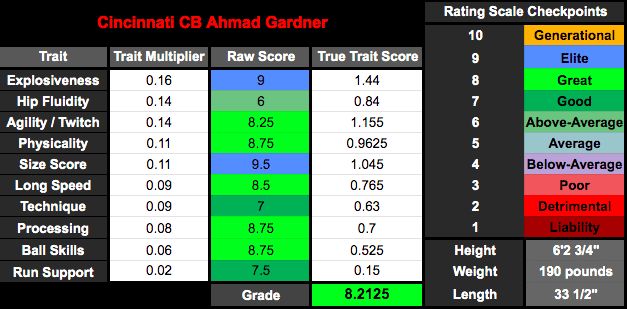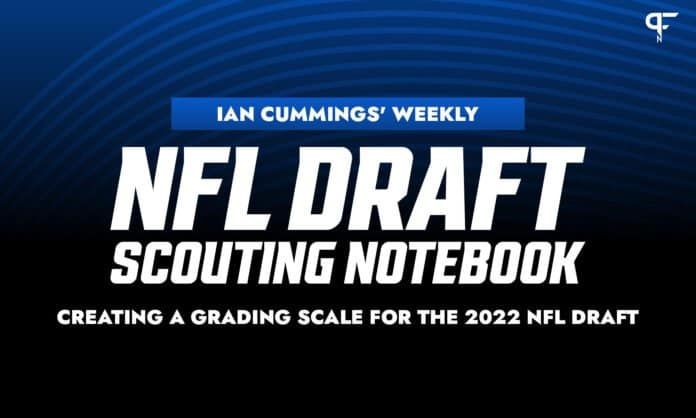One of the most challenging parts of draft evaluation is quantifying one’s analysis. That’s something I’ve begun to explore in the 2022 NFL Draft cycle. For this week’s Scouting Notebook, I’ll give you a look at my in-progress grading scale, my thought process behind it, and some early prospect scores on the scale!
Quantifying prospect grades in the 2022 NFL Draft
I stayed away from grading scales when I started NFL Draft analysis. The process is so purely subjective that a grading scale sometimes feels pointless. It’s nearly impossible to take every detail and consolidate it into consumable, sortable numbers.
During this cycle, however, I opened up to the idea of creating a grading scale. Some things — like character, future durability, and passion — can’t be succinctly quantified. But if you can at least quantify what you see on the field, that can provide valuable context when evaluating prospects. I also found that if you don’t have numbers in place to ground your analysis, you can be more susceptible to implicit bias.
So I created a rough grading scale for the 2022 NFL Draft cycle, with the broad goal of becoming more transparent and more influence-independent as an evaluator. It’s still a work in progress, but here’s an update on how things have developed.
Creating a grading scale for the 2022 NFL Draft
When creating the grading scale, the first task was to distinguish the traits by which prospects should be evaluated. But as an evaluator, I have my own view of which traits are most important at certain positions (or at least harder to develop). Thus, I wanted the scale to reflect that as well.
What I landed on was a weighted scale. I made a list of traits for each position, separating them into several categories. I’m still in the process of finalizing these trait frameworks for certain positions, but the rough category layout is as follows:
- Foundational or Developmental traits: Traits that are inherent to prospects vs. traits that can be developed over time.
- Integral or Secondary traits: Traits that are essential for a given position vs. traits that are not as essential for a player’s main mode of value production.
By this layout, traits were given certain weights. For example, one integral foundational trait is explosiveness. It’s absolutely necessary for most positions, and it largely can’t be developed over time. Thus, it receives a higher weight on the scale.
Another trait example, especially for defensive players, is processing. It’s integral, so it won’t have the lowest weight. But it also allows for more developmental potential than foundational traits like explosiveness and speed. Since players can improve their processing and discipline over time, it receives a lower relative weight. It’s still very important, but not as purely intrinsic as physical upside.
An example of a secondary trait is run blocking for wide receivers. It at least deserves a place on the scale. But more relative value comes from a receiver’s pass-catching and playmaking ability.
Observing the grading scale in action
Now that we’ve gone over how the traits are ranked, let’s take a look at the grading scale in action.
When I was choosing traits to include on the scale, I wanted to break it down as much as I could. For example, as you’ll see with cornerbacks, there are no “man coverage” or “zone coverage” categories. Rather, there are components listed that contribute to success in both of those areas. For example, fluidity, agility, and technique may contribute to man coverage success, while explosiveness and processing elevate prospects in zone coverage.
The exciting part is that by grading these foundational components, you can get an idea of a prospect’s raw ability and potential and also project them into certain scheme fits based on these traits. A great example is Cincinnati cornerback Ahmad “Sauce” Gardner, whose grade is shown below.

Gardner’s grade effectively conveys a lot of his strengths and explains why he’s viewed as a potential blue-chip prospect. He’s supremely explosive and has elite size at his position. He brings great twitch and agility for his frame, and he also processes very well, with near-elite instincts in zone coverage.
However, there are a couple of minor flaws in Gardner’s profile. While he has excellent physicality, he can sometimes get overzealous, which keeps him from attaining an elite score there. His fluidity is also only above-average at best. He’s not a liability there, but he can be a bit leggy on transitions, and there is some stiffness in man at times.
With this information, which is quantified on the grading scale, we can extrapolate and conclude that while Gardner is a strong player all-around, he might best fit into zone-dominant Cover 3 schemes, where his burst, length, and instincts would shine on the boundary.
Closing thoughts on the grading scale
As I mentioned before, this grading scale is still a work in progress. And there are times when inputting the numbers gives a surprising result for certain players — results that may go against preconceived perceptions of that player.
That can be viewed as a flaw, but I appreciate how the grading scale takes me out of my comfort zone. Human perspectives are notoriously flawed and fragile. Errors are easy to make and settle into in draft analysis, and at the same time, the margin for error is very slim.
I’m cognizant of the fact that it’s my perspective from which these grades are coming, which makes the grading scale equally susceptible. It makes the need to mentally reset and isolate yourself when watching the tape all the more important. That way, you aren’t swayed by bias or outside impressions.
But at the very least, this scale allows a controlled environment to quantify a prospect’s cumulative trait outlook and potentially redefine one’s perspective. And I’m excited to keep experimenting and see what results come out of it.

